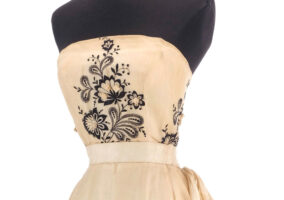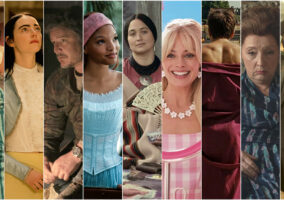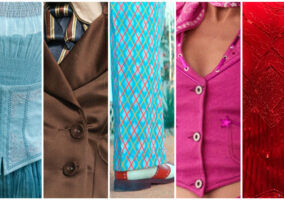![]() Pin
Pin
Call this another lightbulb-going-off instance when, much like with Gabrielle Union’s Bring it On costume, we had to get out of our own heads to consider what makes a costume iconic. Given the current moment, in which the Black Lives Matter movement is ascendant and we’re having a sea-to-shining-sea conversation about our country’s racial history, there’s been a lot of focus on cultural matters viewed through a racial lens. To be perfectly open about it, it’s why we devoted an essay to Scarlett O’Hara’s costume this week and it’s why we’re featuring Black-owned fashion brands under our “Fashion” tab. This is a moment in which Black culture and creativity is being centered just as mainstream culture is being scrutinized more closely for its largely un-discussed racial issues (see: Aunt Jemima). We practically live on social media as a consequence of our career choice, which means all kinds of Black and African-American culture, clips, essays and ephemera have been passing in front of our eyes on an hourly basis for the last few weeks. At some point, this legendary clip surfaced on our timeline:
And our hands, they went a-flappin’.
![]() Pin
Pin
While it’s true that this costume doesn’t necessarily exhibit some of the criteria we’ve been using to declare a film costume iconic (if it becomes a Halloween or Cosplay mainstay), it’s impossible not to see it for the unforgettable and deeply meaning-laden look that it is. For a lot of people, one picture of this costume in its natural setting will immediately set off “Sister, you been on my mind…” playing in their head. And if you’re a true fan of the film, you probably heard “Why, Miss Celie. That mean you still a virgin” in your head as well. It’s a costume so distinct, with such a memorable scene attached to it and unforgettable performer inhabiting it, that it’s capable of triggering an entire retelling of the film’s story as soon as you look at it.
Brandy paid homage to this iconic look in her 2016 video for the song “Beggin & Pleadin.”
And while we wouldn’t normally direct you to a YouTube comments section to illustrate a point we’re trying to make, it’s notable how many viewers immediately got the reference. You put a Black woman in a red sequined dress and beaded headpiece and stand her in front of an audience and a backing band to wail the blues, it’s as easily understood a reference as putting a blonde in a pink satin gown and opera gloves to sing about scamming men for money.
![]() Pin
Pin
But what really got us excited about spotlighting this look was the instant realization of just how much meaning is found in this costume and how much it was saying about both women in its two scenes, encompassing themes of Black womanhood as well as queer love and desire. First, let’s look at the details of it.
![]() Pin
Pin
![]() Pin
Pin
![]() Pin
Pin
The dress is low-cut and skims the body with a barely defined waist, in the style of the time. Also very much situating it within its period: Art Deco detailing in the geometric placement of the sequins and the chevron hem.
![]() Pin
Pin
![]() Pin
Pin
The headpiece is, of course, the focal point, with its festoons of pearls and plumes of peacock feathers, evoking both Native American headpieces and the sort of Ancient World/Near East exoticism popular in theatrical and film costumes of the time and often seen on silent film star Theda Bara, among many others.
![]() Pin
Pin
![]() Pin
Pin
Look at how the red and white stripes of the beads paired with the blue of the peacock feathers gives the look a momentary and unexpected burst of patriotic signaling, which doesn’t really suit the song or style of performance. Put a pin in that.
![]() Pin
Pin
A costume for film is designed not just with the actor in mind, but with the set and art direction as well. Shug had fallen into a bad way when she wound up at Mister’s farm. Given how she was introduced first through glamorous photographs and playbills, it’s easy to surmise that she had a pretty good performing career going on before her undisclosed illness (which is implied to be either drug withdrawal or a venereal infection).
![]() Pin
Pin
The latter scene in her bedroom is festooned with trunks’ worth of costume and jewelry, and while the script implies that she’s not above receiving gifts from sugar daddies, such an extensive collection evokes an extensive theatrical career. She’s clearly meant to be seen as hellaciously talented and charismatic, so there’s no reason to believe she’s some dilettante.
![]() Pin
Pin
Her explosively attention-seeking costume in the setting of a backwoods Georgia juke joint pieced together from random bits of lumber is meant to highlight that she’s fallen from the heights and that this is a temporary stop on her way back to the lifestyle she prefers. In other words, she doesn’t belong here. She’s so incongruous in the setting that you literally cannot take your eyes off her.
![]() Pin
Pin
The film’s costume designer Aggie Guerard Rogers has cited early 20th Century African-American photographer James Van Der Zee’s work documenting Black Americans as the basis for her costume designs and one of the very first pictures that pops up in a Google search is the one that appears at the top of this page, depicting a Harlem dancer in costume, in a headpiece strikingly similar to Shug’s.
![]() Pin
Pin
We can surmise that the headpiece, with its vaguely flag-inspired motif, came from some show she did – possibly even in Harlem – in which such an elaborate and patriotic theme made sense. This is only a few years after World War I, a time when theatrical revues were heavy with “Grand Old Flag” symbolism and themes. There’s no reason to believe that the headpiece and the dress were originally part of the same costume, especially since Celie wears an entirely different matching headpiece when she tries the dress on:
![]() Pin
Pin
The point being that this costume, in the setting of the juke joint and the context of “Miss Celie’s Blues” is meant to demonstrate kinship between the dazzling woman of glamour and talent and the shy, traumatized, frumpy woman wearing an out-of-style hat no observer had seen “since my Mama’s funeral.”
![]() Pin
Pin
That bitchy little line is there for a reason: to draw a line straight from one woman (in a frumpy hat) to another woman (in an old headdress from more glorious days) singing a song to her about how she understands her pain and how she’s lived it herself, in her own way.
![]() Pin
Pin
Steven Spielberg is a master at, among other things, framing. Note how the low angle of the shot makes Shug all the more statuesque, almost overpowering in her grandness (while also noting how literally every other person is in extremely muted colors in order to make her stand out more). Note Mister’s hat in the foreground; another piece of costume design being utilized for thematic reasons.
![]() Pin
Pin
![]() Pin
Pin
Shug crouches down to Celie’s level, pointedly moves Mister’s hat from the space separating them, and just like Celie’s blood sister Nettie used to do, pulls her hands gently down, to stop her from hiding her smile. All the meaning of the song, the scene and even the costumes are there in that gesture. Sisters. Holding hands. Sharing pain. In the words of the song, they’ve both “seen a lot of suns going down.”
![]() Pin
Pin
![]() Pin
Pin
But because this was 1985 (when queerness onscreen was still a bit reluctant or implied) and because Alice Walker’s original novel gave Shug and Celie a much more overtly sexual depiction, Spielberg coyly used the hands of the two women to also signal their sexual attraction and imply the sexual act that follows.
![]() Pin
Pin
![]() Pin
Pin
With that very same dress serving as the literal backdrop for their attraction.
![]() Pin
Pin
This visual motif of hands implying both sisterhood as well as sexual attraction is a function picked up and expanded upon through the use of costume design. The dress implies that Shug has fallen down the ladder from the heights, giving her an understanding of the pain that Celie feels, but it also serves as both a symbol of and catalyst for sexual attraction.
![]() Pin
Pin
Bear in mind that when we first see this dress, Shug is singing a raunchy blues song and every man in the juke joint is declaring her sexual attractiveness. “Girl, I’d drink your bathwater.” “You could catch a fish without a hook.” The dress IS sex (as red dresses so often are on film).
![]() Pin
Pin
![]() Pin
Pin
![]() Pin
Pin
She is the only woman in the scene with bare arms and visible cleavage. The only one covered in sweat. To Celie, this dress represents a boldness and a freedom she desires with every part of herself, which is why it’s so powerful when she puts it on herself, at Shug’s insistence.
![]() Pin
Pin
Celie wearing the dress is a poignant symbol of sisterhood and shared experiences, but it’s also a fulfillment of a wish on Celie’s part; a desire to live inside the skin of this amazingly free and powerful woman. Because the dress is all about sex, the conversation immediately turns toward that subject, with Shug realizing that Celie’s never had an orgasm, due in part to her inability to see herself as desirable or beautiful.
![]() Pin
Pin
The dress itself serves as the tool by which Celie finally experiences joy, achieves sexual fulfillment and gains an understanding of her worth. It would take another decade and a half of story time before Celie could enact those lessons, but the seed of her independence was planted here, on this night, when she put on Shug Avery’s red sequined dress.
![]() Pin
Pin
![]() Pin
Pin
What other costume can do all that, while encompassing themes of Black womanhood, references to World War I patriotism, silent film stars, and African-American theatrical history? What film costume manages to say so much about Black life AND queer desire at the same time? This is one of the many reasons why this costume is iconic: because everyone who looks at it can see a different facet, depending on how the light hits it. Everyone who looks at it sees a slightly different dress. Everyone who wears it tells a different story. What a phenomenal piece of story-telling, character-defining, referential costume design.
[Stills: Warner Bros. via Tom and Lorenzo]
Black-Owned Fashion Brand Spotlight: Duro Olowu Next Post:
Cathy Cambridge Steps Out After Months Inside to Visit a Garden Centre in Norfolk
-
 Pin
Pin
Audrey Hepburn’s Iconic SABRINA Gown Designed by Givenchy to Be Auctioned
-
 Pin
Pin
The 26th CDGA (Costume Designers Guild Awards) Nominees Announced!
-
 Pin
Pin
T LO’s Fave Movie Costumes of 2023, Part ONE
Please review our Community Guidelines before posting a comment. Thank you!
